The Tria Beauty 4X is the only FDA-cleared home-use Diode laser hair removal device. You can use it on body and face. After each treatment fewer hairs grow back, and what does grow back grows slower, lighter and finer. And because the Tria is 3x more powerful than the leading IPL it promises longer-lasting results. Therefore, once you’re smooth and hair-free, you’ll need fewer top-ups to maintain these results. However, sessions are more time consuming than IPL rivals. Learn more about how home laser works here.
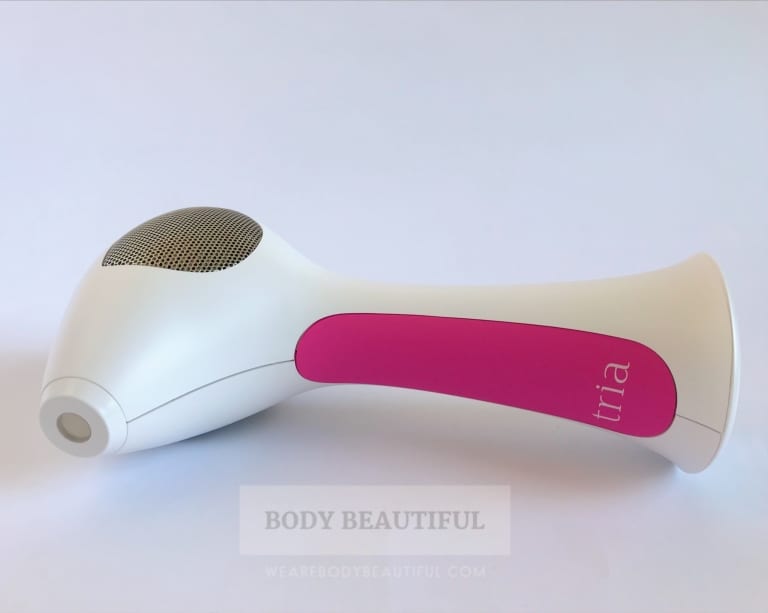
In this Tria 4X laser hair removal review:
First impressions
The box is compact, matt-white, attractive and surprisingly heavy. It’s printed with all the important information such as safe skin tones. This European edition is printed in English, French, German and Dutch.
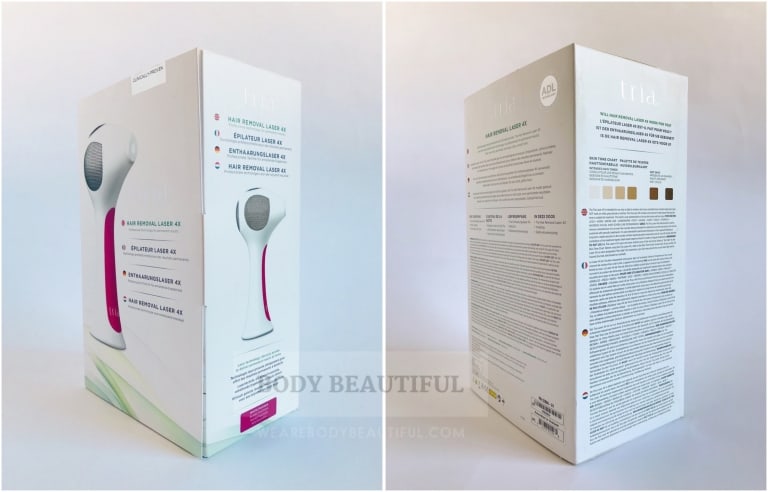
There’s a fold-out flap with more detailed information about how the laser works, what results to expect, the key features and briefly how to use it.
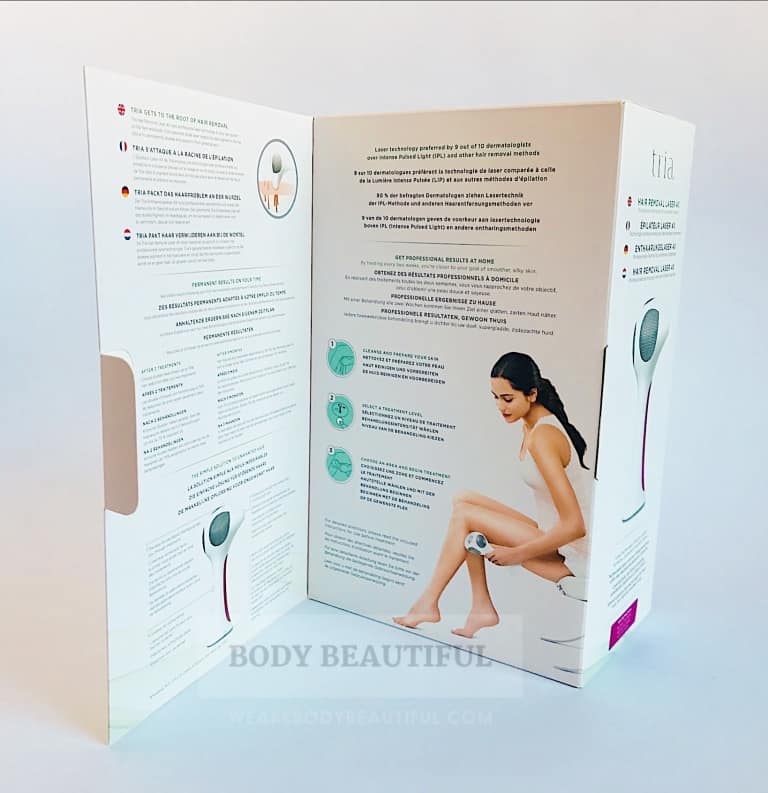
This white sleeve slides off to reveal a sturdy compact box. It’s beautifully done and I can’t wait to see what’s inside.

With the green box sitting flat and secure, gently and slowly slide up the white lid. Don’t do it the other way or you risk the laser device rolling out!
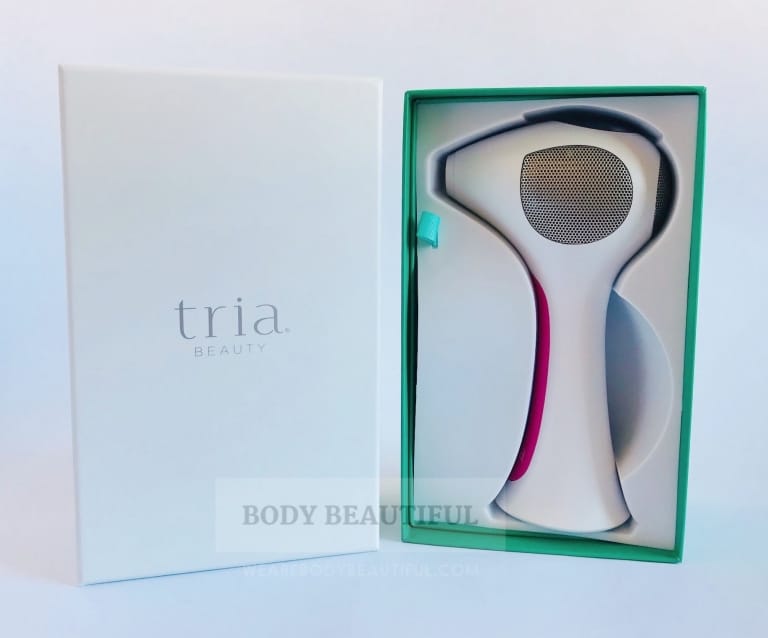
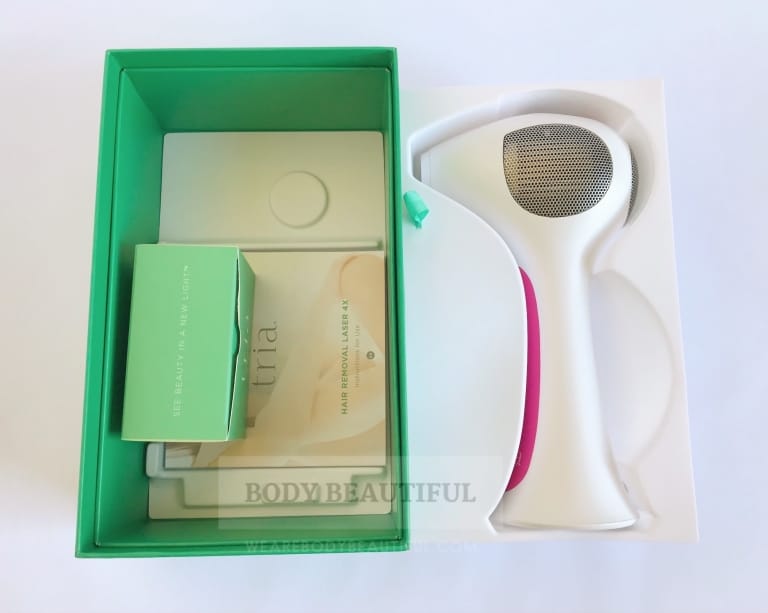

What’s in the box?
- The Tria 4X laser hair removal device
- Charging cable
- Tria Instructions for use booklet
The Tria 4X laser is heavy but it feels balanced to grip. It’s solid, functional. And what it lacks in style it makes up for in character. It reminds me of someone, but I can’t quite think who?
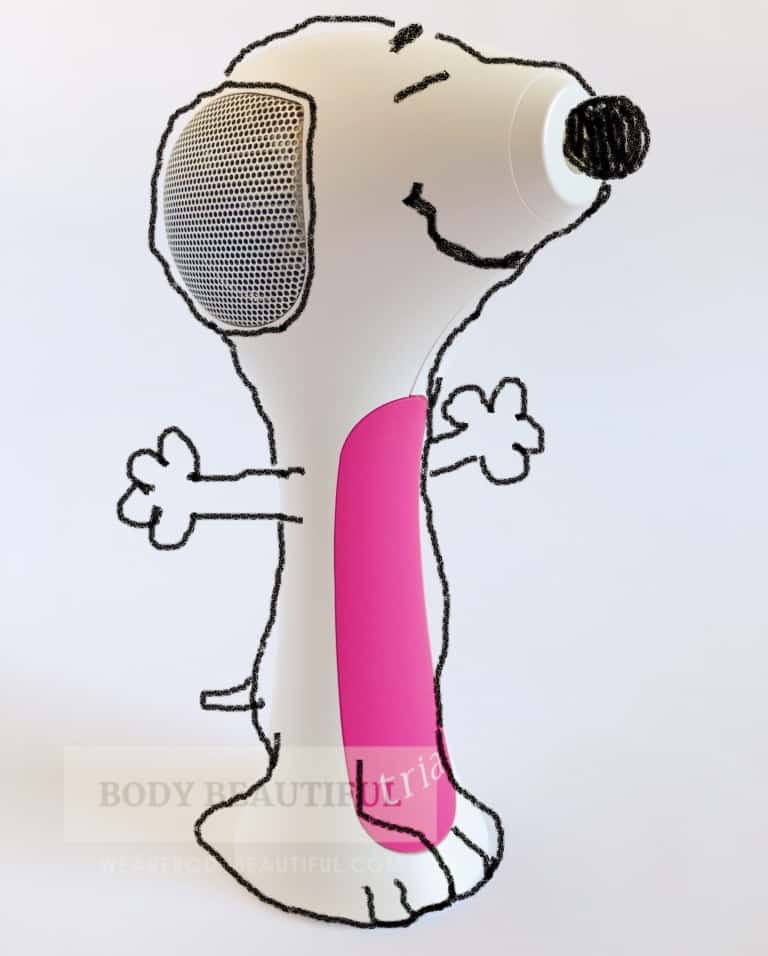
Before you start
Before your first session, you must charge the device, read the user manual, and do a skin sensitivity test. First, find a safe spot and plug the Tria into the mains using the charging cable, then sit down to read the instruction booklet.

The user instructions are well laid out, logical and easy to read. The tone is clear and simple. It concisely explains how the Tria works, uses diagrams to show the features, clearly outlines what results to expect and tells how to use it step-by-step.
Pay close attention to the list of risks, warnings, and reasons you should not use the Tria 4X. These range from pregnancy, diabetes, medical conditions and medications which make you more sensitive to light. Learn more about IPL contraindications here to ensure it’s safe for you. You can also view the user manual on Triabeauty.co.uk.
The manual also explains to do a skin sensitivity test patch at each of the 5 intensity levels in your treatment area. This is both to try which levels are tolerable and test you’ve no skin reactions. Wait 24 hours and if there’s no reaction do your full treatment at a comfortable intensity level.
Getting started
You can learn more about how to prepare for your sessions here. And if you’ll be zapping facial or neck hairs I recommend dermaplaning as an alternative to shaving. Learn more this and about dermaplaning here. And there are deal links for dermaplaning tools at the end of this review.
Here’s a quick summary on how to use the Tria 4X, and there’s loads more detail in the following sections.
- Shave before every treatment (unless there’s no hair left!)
- Press the power button then test your skin tone with the red sensor
- If it’s safe the Tria 4X beeps, unlocks and sets to intensity level 1
- Select your intensity level
- Press on your skin at a 90-degree angle until you hear 2 beeps
- Lift, reposition and repeat on the next spot. Cover your skin in an overlapping pattern of circles the size of the circular nose.
To power-off, long-press the power button until the Tria turns off.
For this review, I treated different body areas including bikini line, underarms and face. I didn’t continue with legs for reasons you’ll learn later in the review. Here’s my feedback.
Design & shape

The laser has a distinctive shape with a teardrop head and a fluted handle. It’s cordless, so there’s no cable to get in the way.
The white plastic case feels robust enough, it doesn’t creak or bend. I like the pink silicone-type grip and the fluted flat bottom so it stands up on its own. But the long handle feels a little hollow. It’s not flimsy, but the finishing isn’t as refined as Philips or Braun.
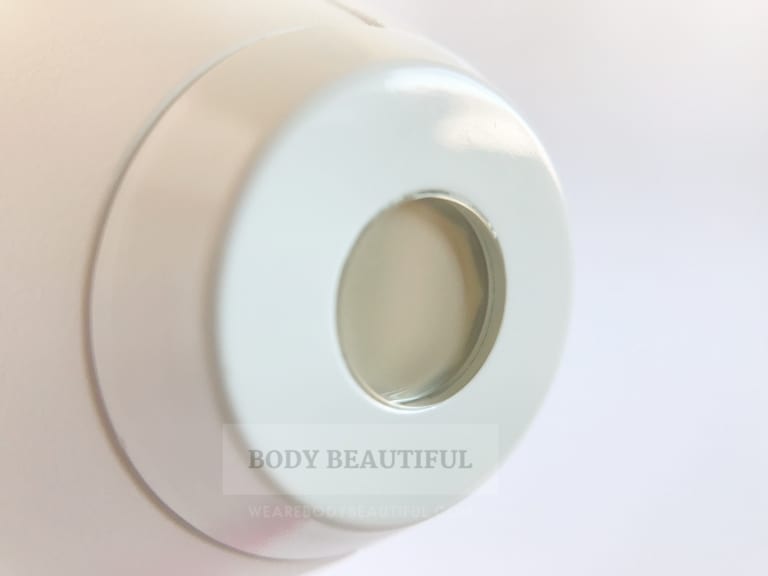
The laser aperture is very small – just over 5mm. You need about about 40 pulses per 10 squared centimetres or 25 pulses per square inch. In other words, it takes a lot of pulses to cover your skin. More on that later.
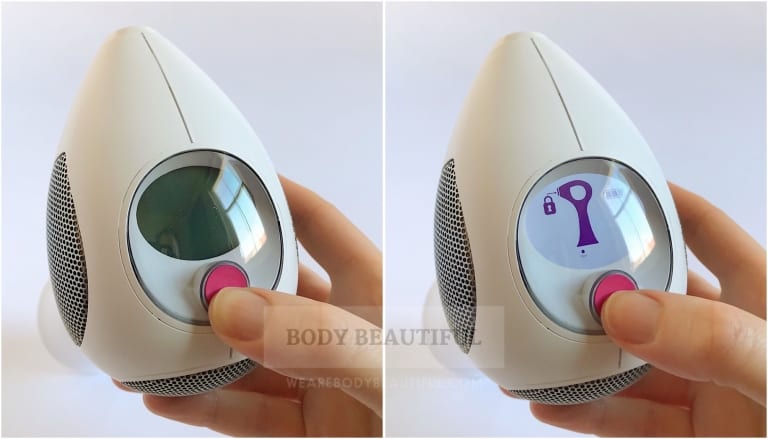
It’s simple and intuitive to operate. Press the power button, then unlock with the skin tone sensor. Then using the power button, cycle through the 5 intensity levels. There’s also a pulse counter (showing ‘0’ below).

The skin tone sensor is on the flat end of the handle. So, with no other controls it’s not in the least bit intimidating for a laser device.
A slight down-side is the laser weighs just under 600g. It’s one of the heaviest home devices. The weight is in the head and it’s balanced, but it starts to feel a bit heavy towards the end of a session. However, our testers agree it’s intuitive and easy to handle. Also, unlike IPL devices, there’s no flash button to press.

Charging & battery life
The power cable is light-weight and does the job. I got a UK and European mains adaptor.

It’s long enough to reach a socket, but I don’t like leaving my laser on charge standing next to the socket. It could easily tip over if knocked. Instead, I lay it in the box.

Each battery charge lasts for around 25 to 30 minutes (around 600 zaps). Then you must recharge the laser for about 2 hours. You can’t use the Tria whilst it charges.
There’s a helpful treatment guide in the user guide booklet. Based on this information, and our tests, you can treat your face and a couple of small areas with one charge e.g. your upper lip, chin, jawline and a pair of underarms, or both sides of the bikini line.
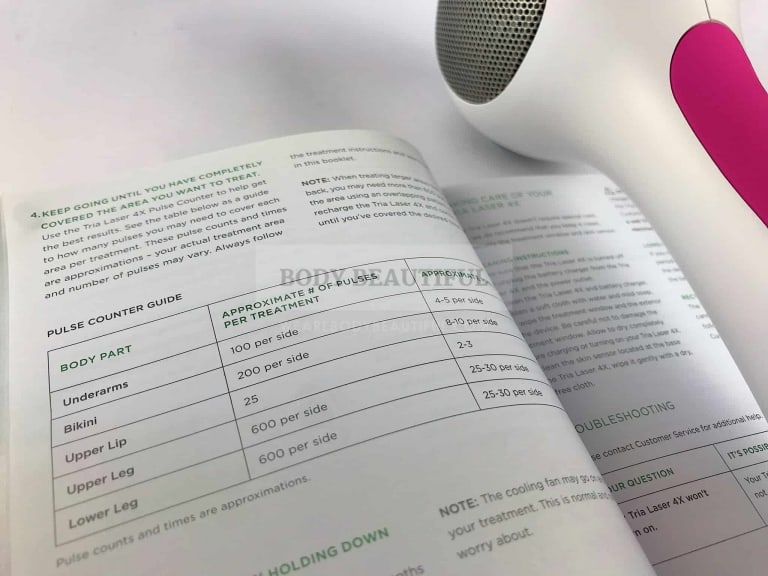
Tria say:
“This battery life allows users to stay focused and conscious of overlapping during treatment.”
Tria Beauty
That’s true. 30 minutes is just right for the high precision and concentration you’ll need. So, it works well for smaller areas and the face you can fit in with one charge. But treating your legs or torso is not fun and it takes ages. There’s more on this later.
Battery maintenance tips
In my user manual (dated 2015), it states the expected service life of the Tria 4X is 3 years. However, a few online reviewers share their Tria 4X doesn’t hold its charge so well anymore. Therefore they get fewer zaps to treat their areas. So, to help maintain the battery life, follow these tips:
- If not in use for long periods of time, charge the Tria 4X every couple of months. This stops it degrading. If you don’t it may stop charging altogether so you can no longer use it
- To prolong the overall life of the battery, use and charge your Tria at a cool temperature. This stops the battery overheating
- Charge the Tria 4X immediately after use so it’s ready to go next time
- Leaving it plugged in once fully charged won’t damage the battery
- You’ll hear the fan as it charges. Long press the power button to turn on ‘Quiet’ charge mode instead (N.B. this takes longer to charge)
How long does the Tria 4X last?
Using a standardised formula, we calculated the lifetime of flashes and pulses for all the devices we test.
Tria say you get a minimum 300 battery charge cycles. Each charge cycle gives you between 500 and 600 pulses. So, assuming 500 pulses from the 5mm aperture each charge, you can cover a minimum total body area of 75,000 cm2. You may get much more.
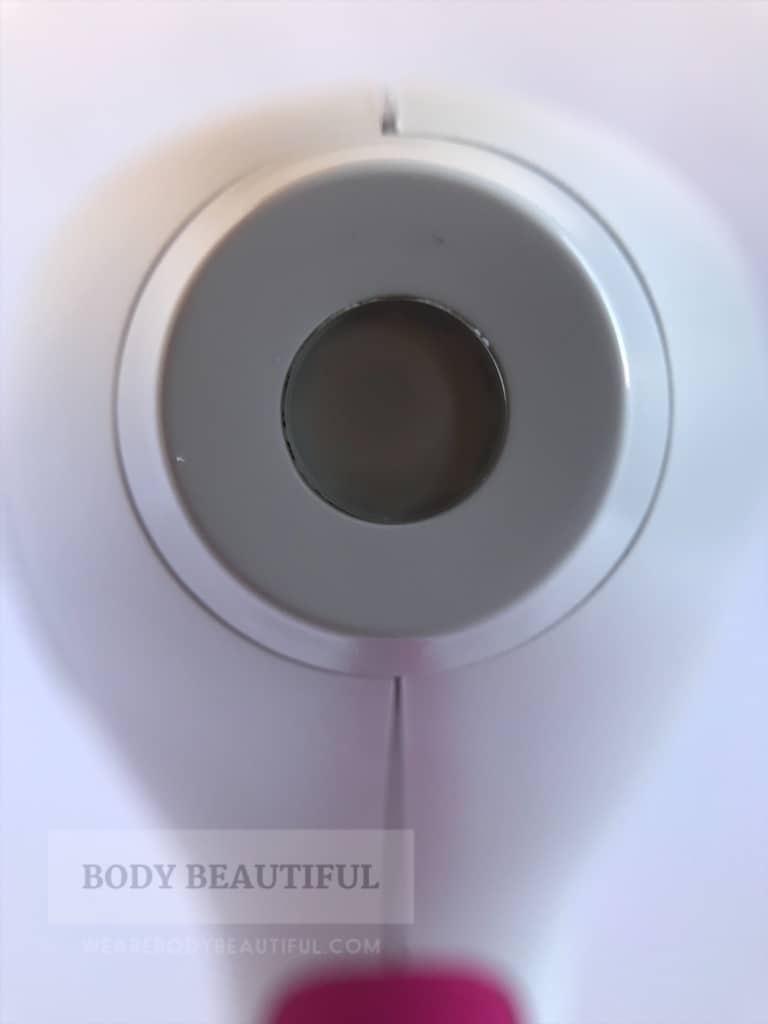
We calculate that’s a minimum of 18 full body treatments (full legs, tummy, bikini line, underarms, forearms and face). Based on Tria’s guidelines that’s enough for the start-up stage and another 10 top-ups. It’ll keep you smooth for a long time. However, following our tests, we don’t recommend the Tria 4X for whole-body hair removal or large areas. Keep reading to learn more.
For small areas you get at least 50 complete treatments. That includes face, underarms, bikini line and forearms. This covers the start-up stage and roughly 3 more years of monthly top-ups. And with the best results possible, you’ll need much less frequent top-ups. Therefore, it’s going to last several years of use.
N.B. I’ve used only the minimum battery cycles shared by Tria and the guideline number of pulses per charge to calculate the years of use. General usage, battery care and wear and tear can also affect how long the machine keeps working.
Power & safety
The Tria 4X has 5 intensity levels, 1 is low and 5 is high. Tria call them ‘comfort levels’ (wait – does that mean it hurts?! More on that later).
The intensities range from 7 to 22 J/cm2. That’s the strongest of all home-use devices. Based on the acknowledged fact the stronger the intensity the better your results, it follows that the Tria promises the longest-lasting results of all home-use systems (if you use the highest settings). But, for a balanced review, be sure to check out the negatives section too.
So, with all that power, safety is very important. And the Tria 4X is clinically-proven safe for home-use. It also passes the necessary European manufacturing and safety standards. Plus, it’s FDA-cleared in the US. Lets’s learn a little more about the eye and skin safety features.
The Tria laser is a Class 1 laser. This means it’s safe and poses no hazard to your eyes when in use. However, there’s an added eye safety mechanism. The laser only pulses when the whole laser aperture is covered by your skin. This prevents accidental pulses near your eyes.
You must also unlock the laser with a safe skin tone. Power it on and place the glowing-red sensor on the handle-base onto your treatment area.

The sensor scans your skin and if it’s too dark it won’t unlock. You can’t use the Tria because it’s not safe.
If it reads a safe skin tone (Fitzpatrick I to IV) it beeps confirmation, the padlock disapears and defaults to level 1 intensity. Use the power button to cycle up the levels and choose your preferred intensity.

What are treatments like?
The Tria 4X communicates with a series of beeps and buzzes. It’s unique and adds to the Tria’s character.
When you power-on the Tria 4X, it beeps once. When you unlock it it beeps in sequence like a little victory call – “duh-duh daah!” And each time you press the pink power button to cycle through the intensities it answers you by beeping once.

Once against your skin, each successful zap is signalled by 2 descending, staccato beeps – “beep bup”! The pulse counter goes up too. If you move the laser before it’s finished a zap it responds with a “beep-buzzz”. This is quite amusing because it sounds like it’s blowing a small raspberry. Stop chuckling, and zap the same spot again until you hear that affirming “beep bup”.
The cooling fan inside only starts when the laser heats up. It’s intermittent so not too annoying.
And unlike home IPL devices, you won’t see any bright flashes of light escaping from the Tria. That’s because the energy is infrared and not visible to us. This means you won’t need to look away with each pulse. So it’s easy to move the small precise head with accuracy.
So, what does the laser pulse feel like, and…
Does Tria 4X laser hurt?
For some people, yes. The Tria 4X laser hurts more than the advertised “rubber band snapping against the skin, or a warm pricking feeling”. Why is this?

All levels of the Tria are safe for up to medium skin tones (Fitzpatrick type IV). Tria advise use the highest tolerable power you can as this gives best results. And their clinical study suggests the higher levels are 2 to 3 times better than the lower ones.
Now, your hair follicle absorbs this powerful laser energy and converts to heat. It’s this heat which hurts. And it’s a hot topic in the user reviews.
It’s described by several as a sharp burning pain that ‘bites’. Whereas some simply use the lower intensity levels, other users numb their skin with ice or lidocaine. But others can’t inflict the pain on themselves so enlist a helpful assistant! Most are willing to keep going for the results, but a few return their Tria because they can’t bear the pain.
Other users report it’s painless or mild to moderate discomfort. But a noteworthy amount say it hurts. However, it should reduce after a few treatments when fewer hair follicles are active.
Unfortunately, there’s no way to know how you’ll feel, but be aware it could hurt and weigh this up in your decision.
Afterwards, your skin may be a bit red and itchy, but this should fade within a few hours. To soothe it, use an ice pack or a wet face-cloth. Cooling water sprays are good too, as is Aloe Vera gel or a non-scented moisturiser. There are some rare, but possible, side effects reported with laser devices too.
Effort & results
Home laser and IPL devices demand effort and commitment. There’s a start-up routine to get you to smooth, and then top-up sessions maintain your results. Your overall effort depends on the number of start-up sessions and how fast each session is. Therefore, we’ve calculated this effort based on our controlled tests, so you can compare and decide if the Tria is right for you.
Tria say you’ll need 8 treatments, one every two weeks, taking up to 3 months to see significant results. Then you can do touch-ups or additional treatments as you need them. Tria also say it’s after another 4 top-ups (totalling 12 sessions) results are ‘permanent’. However, this isn’t a guarantee and you can learn more about this claim in this here article.
Each battery charge last 30 minutes so working in sessions to match, you can zap your face and another small area e.g. underarms or bikini line. Therefore, based on this here’s the overall effort:
This is a lot more effort compared to home IPL rivals which can treat a whole-body with the same effort. But it’s still manageable if you can commit. If you want to treat additional body areas, multiply the total effort column by how many additional 30-minute sessions you need to cover those areas.
As you can see, the Tria 4X is time intensive, the most time intensive and highest effort of all the home devices. Therefore, we don’t recommend it for large areas like legs.
So, what results can you expect?
It’s unlikely they’ll be any change after the first session. Hair won’t suddenly fall out as it can with professional sessions. Shave before your next treatments, and/or in between sessions as you need to.
Usually between sessions 3 or 5 you’ll see a gradual reduction in the number and thickness of your hairs. Hair grows slower and becomes finer, softer and lighter too. Keep going. Shaving becomes much easier because hair’s softer and there’s less of it. Eventually you may not need to shave in between sessions.
Bald patches gradually appear until your skin is smooth. For some this happens before the recommended 8 sessions. Or it may take you longer.
Then, do top-ups as necessary to keep your skin smooth. Tria don’t share how often, so it’s up to you to decide. I suggest monitoring your skin and zapping every 1 to 2 months, or sooner if you notice soft regrowth appearing.
Although Tria say results are permanent after 12 sessions and you don’t need regular top-ups, some user reviews share they do still need them. So, results vary by individual.
In our trial, hair grew slower after the second and third session. Then after 4 sessions, bald patches appeared. Most of the remaining softer and finer hair eventually disappeared after 6 sessions. For the remaining two sessions there was very little, barely visible hair to shave.
Our tester said…
“I’ve now done a total of 11 sessions, the last over 2 months ago. My underarms are still gloriously smooth.”
Negatives of the Tria 4X laser hair removal
Loads of people choose the Tria over IPL hair removal systems because it’s most powerful. They want the best possible results in the shortest time. But it may not be the best choice for you because of some key negatives, as follows.
First, for some it hurts more than a bit, especially on the higher power levels. It’s a sharp, hot, very uncomfortable pricking sensation. And compared to home IPL, the Tria has many more complaints that it hurts. There’s no way to know how intense it’ll be for you, so weigh this up in your decision. The Silk’n Infinity IPL is a much gentler alternative.
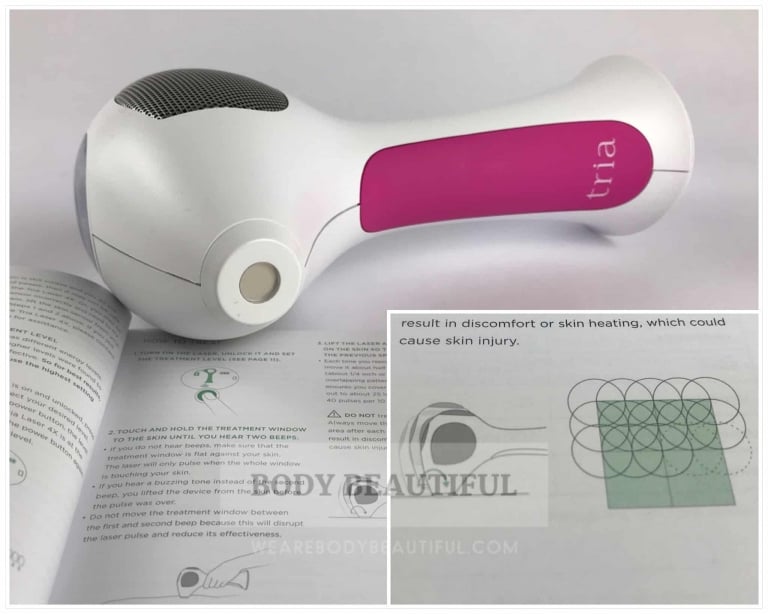
Second, it takes ages to cover large areas. That’s because the laser aperture is very small – just over 5mm. This means it demands close-up precision and concentration to get good coverage. And it takes a lot of overlapping pulses to cover your skin. It’s fine for your upper lip, chin, neck and jawline. But for larger areas or multiple body areas it’s a very time-consuming business. You’ll also need a helpful assistant for chest, back, and back of legs.
Also, each battery charge lasts for around 25 to 30 minutes (around 600 zaps). Then, you must stop and recharge the laser for 2 hours. It’s very tedious on large areas like legs and torso because you’ll need several charges. Then, it’s tricky to remember where you zapped already. Especially if resuming the treatment on a later day.
Based on the user reviews and Tria’s guidance, it takes between 2 to 4 charge cycles per leg (depending on how curvy you are). Therefore both full legs take between 2 to 4 hours of zapping, plus charging time.
Yikes. You must be very committed to stick with this. Home IPL devices are much better suited to large areas and whole body sessions. But as our tester’s confirm, the Tria 4X is manageable on face and small areas, split into 30-minute sessions.
A few niggles…
There are also a few minor niggles to be aware of.
As mentioned earlier, the Tria laser is heavy at 600g. That’s because of the rechargeable battery inside. However, it’s still comfortable enough used in short 30-minute sessions. But, if you want a fast and lightweight device (but without cordless operation) try the Braun Silk Expert Pro 5 IPL instead.
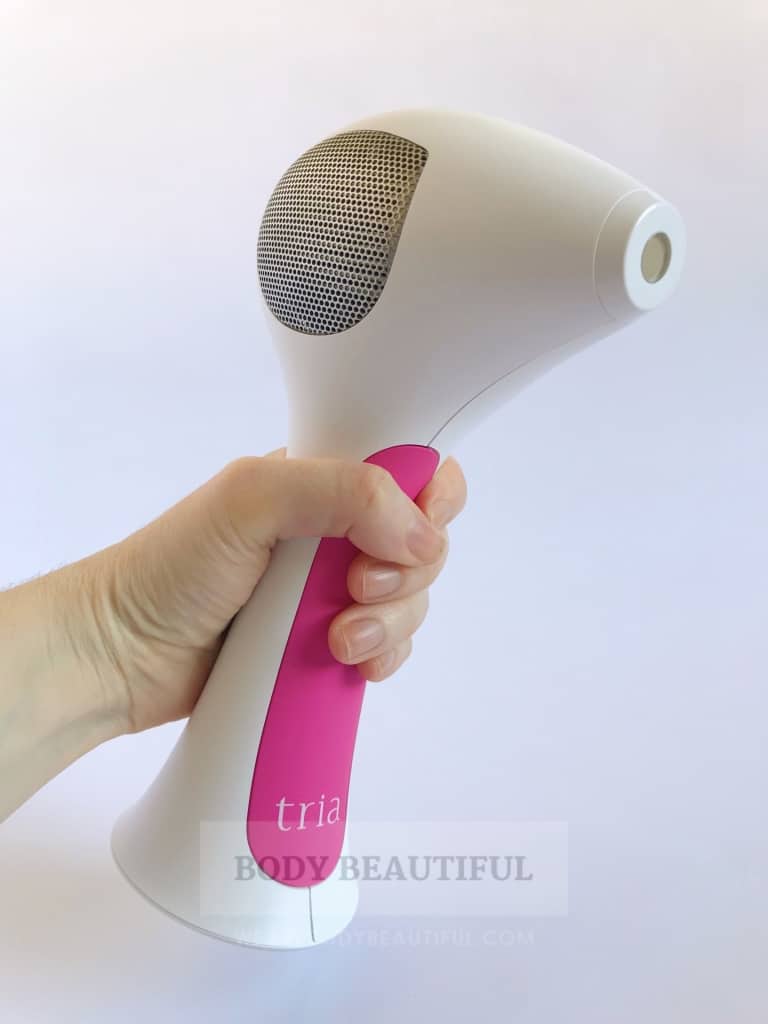
You don’t get a storage pouch with the Tria. So, keep the box to store it in, because this protects it from knocks and dust. And be extra careful when using the laser. It’s delicate despite the weight. Several users complain there’s no repair service with Tria, after they’ve accidentally dropped or damaged it.
Next, a quick summary round-up for you…
Tria 4x laser deals
When you shop via my links I earn a small commission (your price stays the same). I really appreciate your support 🙏!
Tria Beauty UK gives a 60-day money back guarantee & 1 year warranty. The guarantee may not apply to Amazon purchases – please check with the seller before buying!






